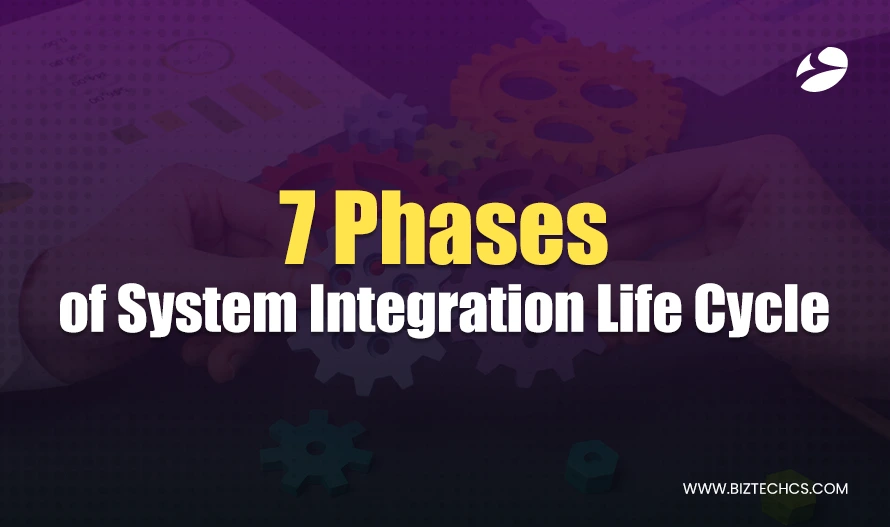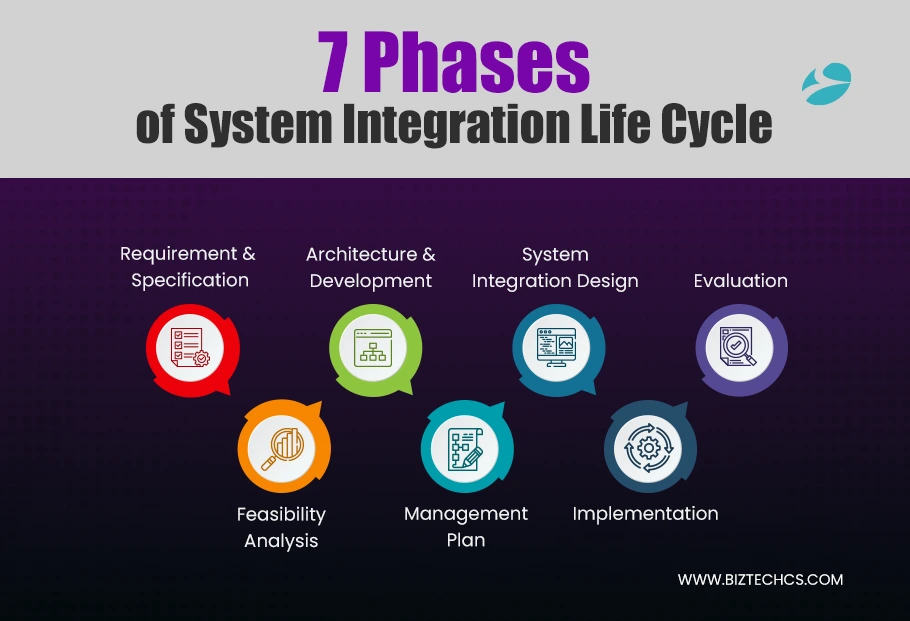24213
7 Phases of System Integration Life Cycle
04 Mar, 2025
10 min read
24213
04 Mar, 2025
10 min read
Table Of Content

An organized procedure is followed to ensure seamless system integration. Seven key phases are included in every successful integration. Many technologies are connected, communicate, and work together as a cohesive system during these stages.
Businesses risk inefficiencies, security flaws, and operational failures if they don’t have a defined strategy. For planning, implementation, and long-term stability, each stage is essential. An integration that is done correctly increases system dependability and productivity. Partnering with dedicated developers can streamline the process, ensuring that each phase is executed with precision and expertise.
We shall dissect the seven system integration life cycle stages and explain their respective significance in this blog.
System integration is the process of connecting different systems, applications, or software to function as a unified whole. The system integration process involves linking various components to ensure smooth data flow and improved efficiency.
A key part of this is phase integration, where different stages of integration are planned and executed step by step. Businesses use system development integration to align new technology with existing infrastructure without disruptions.
Proper integration reduces redundancies, enhances automation, and improves system performance. A well-structured approach ensures seamless communication between different platforms, making operations more efficient.

Before starting the system integration process, gathering and defining requirements is crucial. The customer provides detailed expectations for the integration, covering functionalities, compatibility, and performance. Both systems involved in the integration must be analyzed to ensure smooth connectivity.
Efficiency in documenting these requirements is key to avoiding future challenges. Clear specifications help in identifying potential roadblocks early. This phase integration helps developers understand the scope and objectives clearly.
A well-structured requirement document makes the entire system development integration more seamless.
After defining the requirements, a feasibility analysis is conducted. This phase helps determine if the system integration process is practical and achievable. Research is done to assess the technical, financial, and operational feasibility of integrating the systems.
Potential risks and challenges are identified before starting the development. The outcome of this phase integration influences decision-making on whether to proceed with the project.
Cost estimation and resource availability are also examined carefully. A successful feasibility study ensures that the integration will meet business goals effectively.
System architecture planning is the next step in system development integration. This phase involves creating blueprints and defining how different systems will connect. A well-structured architecture ensures smooth data flow between the integrated systems.
Various components such as APIs, data formats, and communication protocols are decided. Development begins based on the proposed architecture, keeping security and scalability in mind.
The system integration process must support future enhancements and updates. A clear architectural design prevents technical issues in later phases.
Once the architecture is ready, a strong management plan is necessary. This phase involves risk assessments, alternative strategies, and detailed project execution planning. Project managers track timelines, budgets, and resource allocations for the system integration process.
If any issues arise, alternative solutions should be in place. Documentation of each step is crucial for smooth phase integration. A well-planned execution ensures that the project stays on track. Efficient management reduces delays and unexpected costs during integration.
This phase includes both logical and physical designs of the system. The system development integration requires detailed design documentation to guide implementation. Logical design focuses on data flow, workflows, and communication between integrated systems.
Physical design covers the hardware, networks, and infrastructure requirements. System tests are planned to ensure compatibility and functionality. The system integration process must be robust enough to handle expected workloads. Careful design prevents performance issues after deployment.
Implementation is when the integration plan is executed. The system is verified and tested before full deployment. Any errors found during this phase of integration are corrected before finalization. Testing ensures that the integration works as expected without causing failures.
Once verified, the system is deployed in a live environment. Performance monitoring continues to ensure stability. A successful system development integration should be error-free and efficient.
The last phase ensures that the integrated system functions correctly. The system integration process is monitored for any issues post-deployment. Maintenance and modifications are performed as needed. Performance metrics are analyzed to ensure efficiency and reliability.
User feedback is collected to improve future integrations. This phase integration helps refine the system for long-term stability. Continuous evaluation keeps the system optimized for business needs.
Seamless system integration is not just about connecting software—it’s about creating a unified, efficient ecosystem. Each phase in the system integration process ensures smooth transitions, reducing errors and maximizing performance.
Phase integration aligns technology with business objectives, making systems work in harmony. System development integration helps businesses scale without technical roadblocks. With a strategic approach, organizations can enhance productivity and reduce downtime. Additionally, product engineering services play a crucial role in building scalable, future-ready solutions that support seamless integration.
At BiztechCS, we take pride in our expertise, delivering customized integration solutions that fit unique business needs. Our team ensures a smooth transition with minimal disruptions, so businesses can focus on growth.
The seven phases of the SDLC are 1) Planning, 2) Requirements Gathering, 3) Design, 4) Development, 5) Testing, 6) Deployment, and 7) Maintenance. Each phase ensures the software is built systematically and meets user needs.
The most popular SDLC model is the Agile model. It focuses on flexibility, customer collaboration, and frequent updates rather than a rigid structure.
Latest SDLC innovations include DevOps, AI-driven testing, and low-code development. These advancements speed up development, improve quality, and reduce manual effort.
The system integration life cycle follows these stages: Planning, Analysis, Design, Development, Testing, Deployment, and Maintenance. It ensures different system components work together smoothly.
The integration phase of development involves combining various software modules or systems. It ensures they work as a single unit through testing and debugging.
The integration stage in SDLC is when individual components are brought together and tested. This step helps identify compatibility issues before full deployment.

Odoo
291
By Devik Gondaliya
25 Jun, 2025

Odoo
924
By Devik Gondaliya
12 Jun, 2025

Odoo
888
By Devik Gondaliya
11 Jun, 2025